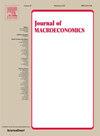需求、财富不平等和商业周期
IF 1.5
3区 经济学
Q3 ECONOMICS
引用次数: 0
摘要
我们考虑一个由异质家庭组成的封闭经济的灵活价格连续时间DSGE模型,这些家庭受到不可保险的特殊收入风险和总TFP冲击的影响。经济生产出各种不完全可替代的最终产品。我们的主要创新是家庭消费和储蓄行为的丰富表示,允许跨品种的时变替代弹性。具体来说,我们考虑一个显示递增替代弹性(IES)的效用函数。我们提供了一个方便的方法来处理复杂的动态规划问题隐含的收入异质性,总冲击和非同质偏好。我们表明,IES偏好有助于复制数据中观察到的财富分配的重要特征,以及合理的宏观经济动态。本文章由计算机程序翻译,如有差异,请以英文原文为准。
Demand, wealth inequality and the business cycle
We consider a flexible price continuous-time DSGE model of a closed economy populated by heterogeneous households subject to uninsurable idiosyncratic income risk and aggregate TFP shocks. The economy produces a variety of imperfectly substitutable final goods. Our main innovation is a rich representation of household consumption and saving behavior allowing for a time-varying elasticity of substitution across varieties. Specifically, we consider a utility function displaying Increasing Elasticity of Substitution (IES). We provide a convenient approach to handle the complex dynamic programming problem implied by income heterogeneity, aggregate shocks and non-homothetic preferences. We show that IES preferences help to replicate important features of the wealth distribution observed in the data together with a plausible macroeconomic dynamics.
求助全文
通过发布文献求助,成功后即可免费获取论文全文。
去求助
来源期刊

Journal of Macroeconomics
ECONOMICS-
CiteScore
2.50
自引率
7.10%
发文量
53
审稿时长
76 days
期刊介绍:
Since its inception in 1979, the Journal of Macroeconomics has published theoretical and empirical articles that span the entire range of macroeconomics and monetary economics. More specifically, the editors encourage the submission of high quality papers that are concerned with the theoretical or empirical aspects of the following broadly defined topics: economic growth, economic fluctuations, the effects of monetary and fiscal policy, the political aspects of macroeconomics, exchange rate determination and other elements of open economy macroeconomics, the macroeconomics of income inequality, and macroeconomic forecasting.
 求助内容:
求助内容: 应助结果提醒方式:
应助结果提醒方式:


